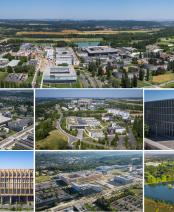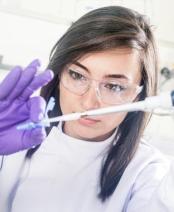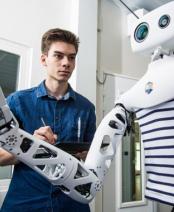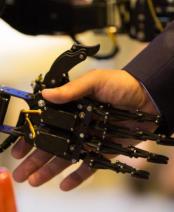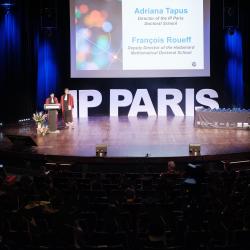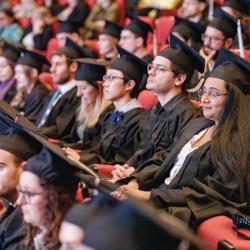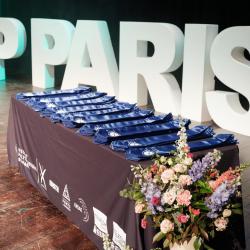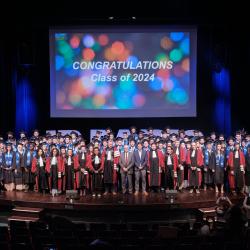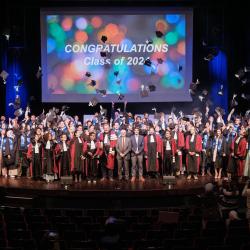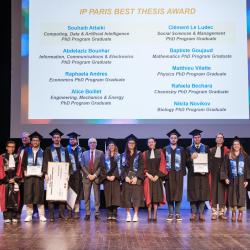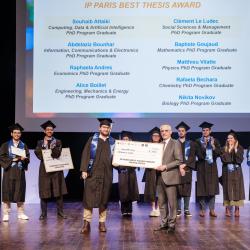IP Paris Best thesis Awards 2025
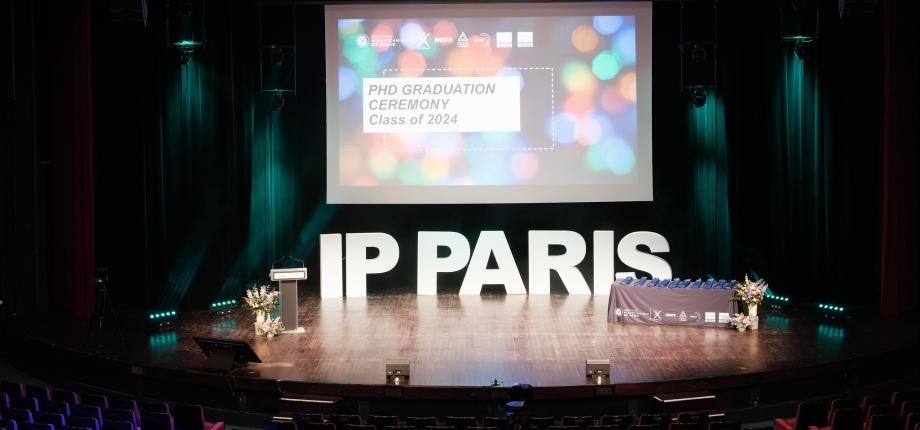
Nine doctoral students stood out in this 2025 edition. Two of them (ex-aequo) were awarded the IP Paris Best Thesis Award, worth €5,000, and seven were recognized in the category of Department Best PhD Thesis Award and received a €3,000 prize.
Award winners in 2025
IP PARIS BEST THESIS AWARDS
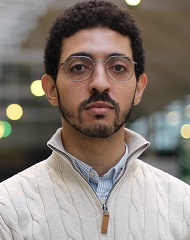
Souhaib Attaiki, Department of Computer Science, Data and Artificial Intelligence, from LIX at École Polytechnique.
Thanks to his thesis, Souhaib Attaiki has overcome a major obstacle to the automatic analysis of 3D shapes: the automatic matching of so-called non-rigid shapes - i.e. shapes that can bend, stretch or deform.
Souhaib Attaiki addressed a major obstacle to automatic 3D shape analysis in his thesis at the École Polytechnique's Computer Science Laboratory (LIX*): automatic matching between so-called non-rigid shapes—i.e., shapes that can bend, stretch, or deform. Combining mathematics, computer science, and artificial intelligence, the young researcher developed new methods for matching complex three-dimensional objects (human bodies, biological structures) even when they are partially observed or differently deformed. The applications are numerous: in medical imaging to compare organs; in 3D animation, to transfer movements from one character to another; and in virtual reality.
“Establishing a correspondence means finding which point on one shape corresponds to which point on another,” explains the young doctor, who received the 2025 Grand Prix de Thèse from the Institut Polytechnique de Paris. “Easy to say, but more difficult to do when the shapes are complex, incomplete, or highly distorted.”
To meet this challenge, Souhaib Attaiki designed new deep learning architectures capable of learning these correspondences without human intervention, even in the absence of annotated data. He proposed a model that allows the two analyzed shapes (Deep Partial Functional Maps) to interact more effectively, whether they are complete or not, and introduced an original method that learns to find consistent correspondences, even without prior examples or when the shapes are very different (Neural Correspondence Prior).
At the same time, the young researcher demonstrated how to improve the internal representations used by neural networks to make them more general, reusable from one task to another, and robust in the face of significant variations. He also designed a zero-shot method, i.e., one capable of establishing correspondences without prior training on a dataset.
These theoretical and practical contributions pave the way for new uses in 3D shape analysis, particularly in contexts where data is scarce or noisy. They are already of interest to several research teams and industrial sectors. “For example, in medicine, they could help detect skull malformations by comparing a child's skull with a reference shape. In the field of animation, they make it possible to transfer the movements of a single character to others, thereby reducing production costs.”
Today, Souhaib Attaiki continues his work in private research, applying AI techniques to image generation. He sees the IP Paris thesis grand prize as an important recognition, which he hopes will also open doors for him in academic research and teaching.
*LIX: a joint research unit CNRS, École Polytechnique, Institut Polytechnique de Paris, 91120 Palaiseau, France
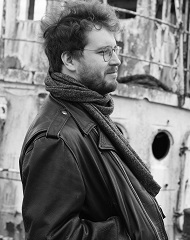
Clément Le Ludec, Department of Social sciences and Management, from i3 SES at Télécom Paris.
In 2017, two economists predicted that 50% of jobs would be fundamentally changed or even replaced by AI. In this climate of concern about the end of work, and to assess the real impact of AI, Clément Le Ludec set out to understand how models are created and how they are used by organizations (companies, public services, etc.).
In 2017, two economists (Carl Benedikt Frey and Michael Osborne) predicted that 50% of jobs would be fundamentally changed or even replaced by AI. "They were actually pointing to tasks that could be replaced by this technology in several professions. However, in this climate of concern about the end of work, and in order to assess the real impact of AI, it is necessary to understand the processes involved in creating models and their use by organizations (companies, public services, etc.) ," explains Clément Le Ludec, from the I3* laboratory at Télécom Paris, winner of the 2025 thesis grand prize from the Institut Polytechnique de Paris.
The young researcher has highlighted a new division of labor brought about by the functioning of AI systems within French startups that produce training data for these models. These startups use subcontractors located in Madagascar to annotate their databases (consisting mainly of images). This organization contrasts with a platform set up by Amazon in the 2010s which, through the principle of micro-work paid by the task, allowed anyone to label data on behalf of companies, researchers, etc. “Another way of working is therefore possible, in which data workers acquire expertise and develop customer contact. This is beneficial for the subcontractor, the startup, and the AI systems they help to build.”
Indeed, the time has come to create AI models that are not only dedicated to research, but also usable on a daily basis and requiring increasingly complex labeling. Clément Le Ludec has thus shown that data workers have strong perceptual abilities and alert AI developers to malfunctions that they might have missed. These qualities are recognized by startups, which naturally gravitate toward countries that are linguistically and culturally similar—often in a post-colonial context—to facilitate conceptual and normative exchanges around the development of AI models. All while keeping costs low. “Unfortunately, working conditions and wages remain inadequate, including in Madagascar. Recognizing the skills required for annotation is therefore essential to improving AI models and the future of data workers.”
In addition, the young doctor studied the impact of this distribution of labeling work on the biases of AI models. From the enactment of annotation rules to their application, it appears that any human decision applied to an AI system generates biases that affect the entire model production chain. “Humans will always have a place in the design of these systems. It is difficult to know how far to go to stop the phenomenon.”
Clément Le Ludec's thesis is fundamental research. However, it resonates with companies in the sector that want to improve their work organization, particularly in light of the European Union's AI Act, which requires simplified data sets, improved working conditions for data professionals, etc.
*Institut Interdisciplinaire de l'innovation (i3): CNRS, École polytechnique, Mines Paris-PSL, Télécom Paris, Institut Polytechnique de Paris, 91120 Palaiseau, France
DEPARTMENT BEST PHD THESIS AWARD
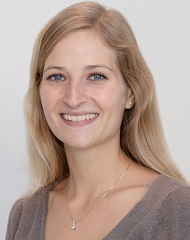
Raphaela Andres, Department of Economics, from CREST/ i3 SES (Télécom Paris) laboratory.
How can we improve society and the economy by reducing the risks associated with digital technology? To answer this question, Raphaela Andres conducted an empirical study on political and managerial interventions in the digital economy. She then analyzed their effectiveness and potential side effects.
How can we improve society and the economy by reducing digital risks? Raphaela Andres, winner of the 2025 thesis prize from the Department of Economics at the Institut Polytechnique de Paris, has tackled this question. A graduate of CREST* at Télécom Paris, she conducted an empirical study on political and managerial interventions in the digital economy. She then analyzed their effectiveness and potential side effects.
Raphaela Andres's first task was to study the effects of the public aid policy for businesses in economically disadvantaged regions of Germany. This policy provides financial assistance to businesses wishing to purchase, for example, computer equipment. With investment costs reduced, younger people are directing their spending in this direction, to the detriment of software purchases, which are often preferable. “This hinders the development of these companies. The aid is therefore no longer optimal, either for them or for the economy. It is now necessary to evaluate this outdated public policy and update it regularly, particularly in view of the rapid pace of societal and technological change.”
Social media, and more specifically the German-speaking community on X, were also within Raphaela Andres' scope. She assessed the prevalence of hate speech after the adoption of a law (Network Enforcement Act) reassigning responsibility for comments made or left visible to the platforms. “Hate speech persists on X, where its authors are still present but more moderate. However, it is shifting to smaller platforms.” Due to their small size and the high costs associated with moderation, the law deliberately excludes the latter. The words are there, virulent, but their reach remains limited due to the small size of the communities. “The text therefore has an impact.” The study also offers an overview of the potential effects of the Digital Services Act introduced by the European Union.
The young scientist completed her work by analyzing the impact of regulations on the creative economy. In 2017, many brands left YouTube so as not to be associated with hostile content hosted on the platform. This “Adpocalypse” prompted the famous network to tighten its moderation policy. Creators publishing content simultaneously on multiple platforms (multihoming) adapted by investing more in other sites. “A platform like Patreon has more comments, memberships, and likes, but less toxicity after YouTube's intervention.”
Raphaela Andres addresses her work to public decision-makers and managers in the digital economy. She emphasizes that in this field, it is more necessary than ever to take into account all stakeholders and the rapid pace of technological change.
*CREST: a joint research unit CNRS, École Polytechnique, GENES, ENSAE Paris, Institut Polytechnique de Paris, 91120 Palaiseau, France
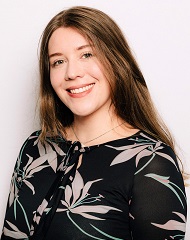
Rafaela Bechara, Department of Chemistry and Chemical Engineering, from PMC laboratory at École Polytechnique.
In chemistry, to transform product A into B via a reaction, sometimes a little help is needed—catalysis—using a specific molecule—the catalyst. During her thesis, Rafaela Bechara worked on processes to simplify catalysis and improve the efficiency of the reactions involved, all with a view to green chemistry.
Rafaela Bechara fell in love with catalysis while studying for her bachelor's degree in Brazil and has been hooked ever since, joining the PhD Track at the Institut Polytechnique de Paris. “In chemistry, to transform product A into product B via a reaction, you sometimes need a little help—catalysis—using a specific molecule—the catalyst,” explains the young researcher, winner of the thesis prize from the Chemistry Department at the Institut Polytechnique de Paris, who graduated from the Condensed Matter Physics Laboratory at the École Polytechnique (PMC*). "The process is commonly used in industry because it saves reaction time. It is also one of the major concepts of green chemistry, which seeks to use fewer resources and release fewer pollutants."
However, when the catalyst is present in the same medium as the other reactants (homogeneous catalysis), it must be isolated from the product obtained using purification processes that are often lengthy and costly. “During my thesis, I managed to fix catalysts onto solid silicon supports (such as those used for photovoltaics), which allows them to be separated from the products by simple filtration,” enthuses Rafaela Bechara. A unique feature of the process is that the molecules are actually integrated into polymer chains that the scientist grows on these supports. “This means there are more catalysts per unit of silicon surface area, increasing the efficiency of the reaction.”
To achieve this, the chemist developed a microwave grafting process that fixes the polymerization initiator to the silicon substrate. She then used Salen complexes—organic molecules containing a metal—as catalysts. “They are multitasking and really advantageous because you just need to change the metal to catalyze other reactions.” Rafaela Bechara applied this technique to macroporous silicon with the idea that the pores offer more surface area for polymers to attach to and therefore more catalysts per unit area. “Experiments have shown that porous silicon nanoparticles must be used to obtain enough usable surface area and perform the catalysis tests. This will be the next step in this work.” At the same time, the young doctor developed a technique using only the polymer-catalyst combination. This can then be recovered by simple precipitation and reused up to seven times while retaining its reactive power. A real saving in atoms!
Now a graduate, Rafaela Bechara has joined the Collège de France, where she is working on homogeneous catalysts and photocatalytic reactions. “I continue to play with chemistry and explore it to make it ever more interesting and greener.”
*PMC: a joint research unit CNRS, École Polytechnique, Institut Polytechnique de Paris, 91120 Palaiseau, France
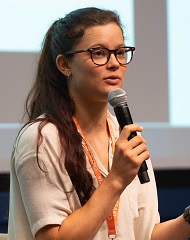
Alice Boillet, Department of Mechanics and Energetics, from LadHyX laboratory at École Polytechnique.
Alice Boillet's work lies at the intersection of mechanics, modeling, and physiology. During her PhD, she developed digital twins of athletes and mechanical models to determine optimal effort management strategies in track cycling and rowing, with a view to the Paris Olympics.
At first glance, cycling and rowing are two sports that are completely different... except for Alice Boillet, winner of the thesis prize from the Engineering, Mechanics, and Energy Department at the Institut Polytechnique de Paris and former PhD student at LadHyx*. “From a mechanical standpoint, both disciplines involve races with cyclical movements. Physiologically, in both cases there are middle-distance races/events that mobilize the same energy systems,” explains the young doctor. It is therefore at the intersection of mechanics, modeling, and physiology that Alice Boillet's thesis came to life.
“I started my PhD exactly three years before the Paris Olympics, as part of the Sciences 2024 program. The timing was perfect and the work promised to be exciting.” Alice Boillet's mission was to answer questions from federation coaches by determining optimal effort management strategies.
In cycling, the young doctor focused on the team pursuit on the track. The aim was to determine the optimal relay based on the athletes' physiological characteristics. “To do this, I developed a digital twin model of the athletes that only needs to be parameterized with their usual physiological measurements, such as VO2 max (editor's note: VO2 max corresponds to an athlete's maximum oxygen consumption per unit of time and maximum ”aerobic" capacity). The model also predicts, in a non-invasive way, the athletes' muscle lactate levels (editor's note: lactate accumulation is associated with maximum “anaerobic***” capacity). We can then have them run a virtual race and anticipate the impact of the race on their fatigue and physiological state." At the same time, Alice Boillet used a mechanical model to predict runners' speed based on the power they generate. Knowing the distance of the course, it is possible to deduce a theoretical finish time. From there, different racing strategies can be tested and optimized using these two coupled models.
“My work also attracted considerable interest from the rowing federation when the race distance at the upcoming Olympic Games in Los Angeles was shortened from 2,000 meters to 1,500 meters.” The announcement raised many questions: should athletes start at the same speed, should their training be modified, etc.?
Alice Boillet shared her model with sports federations and now works for an orthopedic equipment manufacturer as an R&D engineer. "The IP Paris thesis prize remains, however, a recognition of my work and my legitimacy in a field that was unfamiliar to me and in which I had to assert myself as a woman. It is an honor for me to have received it."
* LadHyX: a joint research unit CNRS, École Polytechnique, Institut Polytechnique de Paris, 91120 Palaiseau, France
** The aerobic energy system enables endurance efforts lasting from a few minutes to several hours, such as running a marathon.
***The anaerobic energy pathway allows for the sudden activation of a muscle group to perform a brief, intense movement or effort.

Abdelaziz Bounhar, Department of Information, Communication and Electronics, from LTCI laboratory at Télécom Paris.
How can connected devices transmit data efficiently while remaining undetected? This is the subject of Abdelaziz Bounhar's thesis, which focuses on reinforcement learning and covert communication for the Internet of Things (IoT).
How can connected devices transmit data efficiently while remaining undetected? This is the subject of Abdelaziz Bounhar's thesis, a former PhD student at LTCI* of Télécom Paris, which focuses on reinforcement learning and covert communication for the Internet of Things (IoT). This fundamental research earned him the 2025 PhD Thesis Award from the Information, Communications, and Electronics Department of the Institut Polytechnique de Paris.
While cryptography secures information transmission through encryption keys, it is energy-intensive and makes data exchanges detectable. Covert communication, on the other hand, consumes very little energy, remains undetectable, and can also be secured using encryption keys. It is therefore ideally suited for IoT — for example, in the healthcare sector, where confidential and personal data is transmitted between devices, or in industry, where energy efficiency is essential for devices operating autonomously over long periods.
In this context, Abdelaziz Bounhar explored the fundamental limits of covert communication and the optimization of user networks using artificial intelligence (AI). He first mathematically characterized the relationship between the maximum data rate a covert user can achieve and the size of the key used to encrypt messages.“I showed how to dynamically adapt the communication rate based on the available key, regardless of its size. This is a crucial challenge, as key generation is costly in terms of time and resources — yet, until now, it had remained unsolved.”
The young researcher also discovered a novel phenomenon: beyond two users on a network, covert communication allows multiple users to transmit at maximum data rates simultaneously. “No user needs to reduce their data rate for the others, meaning no trade-off is required between them.”
He then turned his attention to more realistic and complex configurations, in which covert and non-covert users coexist. Not only did he characterize the fundamental limits of these hybrid systems, but he also developed algorithms based on reinforcement learning to optimize communication networks. Indeed, in such mixed setups, data rate requirements vary, and it becomes essential to prioritize transmissions. “AI — especially reinforcement learning — helps determine an optimal communication policy by taking into account data types, channel quality, energy requirements, and more.”
Today, AI is also being used in another context: to intelligently compress the information being transmitted. It enables systems to focus on the core, action-relevant content. “This is the semantic aspect of information. Imagine a smart home system’s AI needs to recognize a cat to unlock a cat flap. There's no need to send a full, heavy image of the cat — just a few key features are enough.” In this context, Abdelaziz Bounhar defined the fundamental limits of semantic communication within a covert communication framework.
Although Abdelaziz Bounhar’s work remains theoretical, this thesis award is a testament to its high potential. Now an AI Research Engineer at a university in the UAE (MBZUAI), he focuses on reinforcement learning for reliability (alignment) and AI safety, while also contributing to the training of increasingly powerful large language models (LLMs).
*LTCI: a research lab Télécom Paris, Institut Polytechnique de Paris, 91120 Palaiseau, France
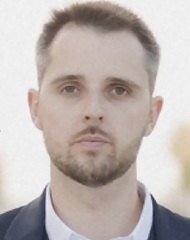
Baptiste Goujaud, Department of Mathematics, from CMAP laboratory at École Polytechnique.
Machine learning, neural networks, deep learning...All of these rely on learning algorithms that need to be optimized to improve their predictions. Baptiste Goujaud conducted fundamental and theoretical research to analyze these algorithms and provide the scientific community with a toolbox that makes them easier to use.
Machine Learning, neural networks, deep learning... Everything relies on learning algorithms that need to be optimized to improve their predictions. During his PhD — for which he received the 2025 PhD Thesis Award from the Department of Mathematics at the Institut Polytechnique de Paris — Baptiste Goujaud conducted fundamental and theoretical research to analyze these algorithms and provide the scientific community with a toolbox to facilitate their use.
Let’s set the stage. In machine learning, as in computer science in general, a program is a function. This ranges from a simple operator like a sum to a more complex task like object recognition in an image or natural language processing. “Input an image of a dog or a cat into a computer. We want it to be able to say which one it is. To find the right function, it must be defined using many variable parameters and the computer must be given examples of correct predictions. For each value of these parameters, the computer can determine an error rate based on the provided examples and adjust the parameter values to keep improving,” explains the young PhD graduate from the Centre de Mathématiques Appliquées (CMAP*) at École Polytechnique.
Iterative algorithms can carry out this adjustment work with varying degrees of efficiency. Some will test values of the error function to be minimized by trying them one by one and relying on a large number of tests. Others will calculate the derivative of the function at just a few points. They will determine whether values are increasing or decreasing and will look for other points in the direction that minimizes the function. And so on... “This is the case for the Heavy Ball algorithm, developed in the mid-1960s.”
This algorithm is very well described and optimal for so-called quadratic functions (i.e., of the form f(x) = ax² + bx + c). However, while it seems suitable for many other types of functions, no one has ever been able to prove that it is ideal in those cases. “I proved that this is, in fact, unprovable, because there will always exist functions for which Heavy Ball is not optimal or does not work.”
More generally, Baptiste Goujaud studied a branch of optimization focused on automating the analysis of algorithms. The goal is to compare their performance, defined by the number of iterations needed to reach a satisfactory result. The ultimate objective is to be able to “prescribe” the right algorithm for a given problem, based on the error function that characterizes it. “The idea was to tell users: you're dealing with this class of functions, use this algorithm and you’ll obtain a simpler, more digestible function for the computer. The tool we studied helps accelerate the search for such a solution by making it as automated as possible.” The young researcher thus developed a software solution enabling users to make such discoveries more quickly.
Today, Baptiste Goujaud is focusing on other areas of machine learning optimization at Inria. He will soon become a lecturer at Télécom SudParis, where he will continue to explore this topic.
*CMAP: a joint research unit CNRS, Inria, École Polytechnique, Institut Polytechnique de Paris, 91120 Palaiseau, France
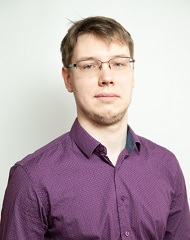
Nikita Novikov, Department of Biology, from BIOC laboratory at École Polytechnique.
The phenomenon of cell migration is involved in many physiological and pathological processes — notably the development of cancer metastases and wound healing — but the molecular mechanics governing it are still not well understood. This is where Nikita Novikov’s PhD thesis comes in.
Cellular and molecular biology has yet to reveal all its secrets — particularly those of cell migration. This phenomenon is involved in many physiological and pathological processes — notably the development of cancer metastases and wound healing — but the molecular mechanics behind it are still not well understood. This is where the work of Nikita Novikov comes in, awarded the 2025 PhD Thesis Prize from the Department of Biology at the Institut Polytechnique de Paris.
The young researcher from the Structural Cell Biology Laboratory (BIOC*) at École Polytechnique focused on a protein associated with a rare genetic disease (Nance-Horan Syndrome), already identified as part of the molecular machinery involved in cell migration. “My work first revealed that the NHSL3 protein plays a role in different modes of cell migration. In individual migration, it disorients the cell (a negative impact), making it unsure of which direction to take. In contrast, during collective migration, it facilitates coordination between leader and follower cells.”
Nikita Novikov then set out to understand the specific mechanisms by which NHSL3 functions. He studied all the different forms the protein could take and searched for the molecules with which it might interact to regulate cell migration. This so-called proteomic approach revealed over 340 potential partners of NHSL3. Manually sorting through them to identify the relevant ones would have taken years. “So I turned to a protein structure prediction tool based on artificial intelligence (AlphaFold2), which my BIOC colleagues had enhanced for this purpose.”By verifying AlphaFold2’s results through standard cell and molecular biology experiments, Nikita Novikov confirmed the AI’s predictions. “The molecules identified are indeed those that regulate the mechanics of cell migration, in conjunction with NHSL3.”
Through this work, Nikita Novikov addresses one of the major challenges in proteomics: analyzing and sorting large volumes of data. “My thesis opens a new research methodology by effectively combining cutting-edge computational techniques with cell biology.” It will serve as a model for understanding and identifying the specific molecular mechanisms that regulate various cellular behaviors.
Today, the researcher continues his work at BIOC. “I still have many datasets collected during my PhD to analyze. I will then focus on the detailed study of the molecular mechanics in which NHSL3 and its partners are involved.”
*BIOC: a joint research unit CNRS, École Polytechnique, Institut Polytechnique de Paris, 91120 Palaiseau, France
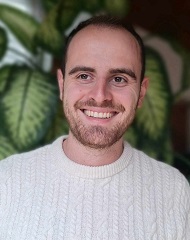
Matthieu Vilatte, Department of Physics, from CPHT laboratory at École Polytechnique.
During his PhD, Matthieu Vilatte studied gravitation from a quantum perspective. A highly theoretical endeavor, in which the young researcher focused on exploring the boundaries of space-time in order to identify mathematical objects capable of describing the phenomena occurring within — in a quantum framework.
From the Institut Polytechnique de Paris to the University of Thessaloniki in Greece, Matthieu Vilatte spent three and a half years studying gravitation from a quantum perspective. “Of the four fundamental forces in nature*, it is the only one that has not been unified with the other three, which make up the Standard Model of particle physics.” Indeed, the latter describes objects evolving in a space, whereas “with gravitation, one must describe space itself — and therefore think differently,” explains the winner of the 2025 PhD Thesis Prize from the Department of Physics at the Institut Polytechnique de Paris.
To try to resolve this problem, Matthieu Vilatte — from the Centre for Theoretical Physics at École Polytechnique (CPHT**) — focused on the AdS/CFT*** theory (a topic related to string theory). This theory shows that by studying the boundary of space-time, it is possible to find mathematical objects capable of describing, in quantum terms, the phenomena occurring within. “This is the principle of holography. The relevant information contained in space-time is projected onto its boundary.”
One important detail must be noted: scientists have shown that this form of holography only works for saddle-shaped space-times (negative curvature). However, such geometries are theoretical and do not exist in the universe. The young researcher therefore focused on a flat space-time of reasonable size — that of our galaxy — whose physical behavior at its boundary is known, though intriguing. “This physics, known as Carrollian, allows — through its geometry and the fields it supports — for the description of quantum gravitational phenomena from the perspective of flat interiors.” The flat space-time model studied by Matthieu Vilatte includes the interactions between observable black holes and, at its boundary, Earth. This is where the LIGO and VIRGO interferometers revealed the existence of gravitational waves. “If two black holes merge somewhere in the galaxy, the generated waves will distort space-time and be detected by LIGO and VIRGO. This data constitutes the only source of information available to test our model — that is, to verify our boundary theory.”
During his PhD, the young researcher tested his hypothesis by studying theories that conform to Carrollian geometry. He demonstrated that, similar to results obtained at the boundary of negatively curved space-times, the equations governing the objects responsible for gravitational waves can be reproduced from a model defined solely on the boundary of flat space-times. “This is the first major discovery in support of the existence of a flat holographic principle to understand gravitation quantumly in the real universe.”
Today, Matthieu Vilatte is continuing this promising work as a postdoctoral researcher at the University of Mons in Belgium, while also conducting research on black holes and thermalization. “I hope, eventually, to rely on the quality of my education at IP Paris to become a lecturer-researcher.”
* electromagnetic, strong nuclear, weak nuclear, gravitational
** CPHT: a joint research unit CNRS, École Polytechnique, Institut Polytechnique de Paris, 91120 Palaiseau, France
*** AdS – negatively curved (Anti-de Sitter) / CFT – conformal field theory
LIX: a joint research unit CNRS, École Polytechnique, Institut Polytechnique de Paris, 91120 Palaiseau, France
Institut Interdisciplinaire de l'innovation (i3): CNRS, École polytechnique, Mines Paris-PSL, Télécom Paris, Institut Polytechnique de Paris, 91120 Palaiseau, France
CREST: a joint research unit CNRS, École Polytechnique, GENES, ENSAE Paris, Institut Polytechnique de Paris, 91120 Palaiseau, France
PMC: a joint research unit CNRS, École Polytechnique, Institut Polytechnique de Paris, 91120 Palaiseau, France
LadHyX: a joint research unit CNRS, École Polytechnique, Institut Polytechnique de Paris, 91120 Palaiseau, France
LTCI: a research lab Télécom Paris, Institut Polytechnique de Paris, 91120 Palaiseau, France
CMAP: a joint research unit CNRS, Inria, École Polytechnique, Institut Polytechnique de Paris, 91120 Palaiseau, France
BIOC: a joint research unit CNRS, École Polytechnique, Institut Polytechnique de Paris, 91120 Palaiseau, France
CPHT: a joint research unit CNRS, École Polytechnique, Institut Polytechnique de Paris, 91120 Palaiseau, France









